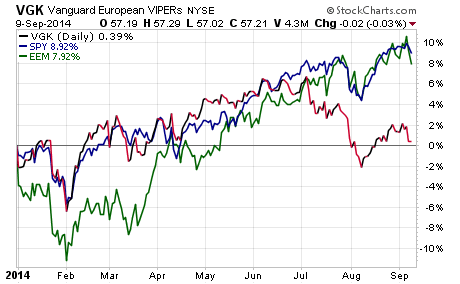How to Play ETFs to Win in European Stocks
Post on: 31 Март, 2015 No Comment

Recent Posts:
How to Use ETFs to Win in Europe
On April 20, Morningstar ran an article about European ETFs that included several specific recommendations. It reasoned that while European leaders have yet to address the root causes of the Continents financial crisis, the low valuations of European equities provides investors with remarkable opportunities. However, the story cautions that the turnaround in Europe will be measured in years, not months, so patience is essential.
Heres how you can use ETFs to win the European game.
The top pick of the Morningstar analysts is Vanguards MSCI Europe ETF (NYSE:VGK ). It tracks the MSCI Europe Index, holds 457 stocks and has an expense ratio of just 0.14%. Thats cheaper than any other comparable European ETF.
I dont think you can go wrong with Vanguard. Its top 10 holdings account for just 21.3% of total assets, so diversification is not an issue. Morningstar does make the point that over the past 10 years, the S&P 500 was closely correlated (about 91%) with the MSCI Europe index. Nonetheless, Europe accounts for 25% of the worlds market capitalization. To avoid such a big part of the worlds stock markets is what they call home-country bias, and it can lead to long-term underperformance.
An excellent way to make money with ETFs which can also be done with stocks, though not as easily is to buy an initial amount and then some more every 365 days. Theres a catch: Rather than practicing whats essentially a form of dollar-cost averaging, youll buy more only if the price is lower than the previous years close.
For example, lets say you bought 100 shares of the Vanguard fund at the May 9 high of $43.01. If on May 8, 2013, it closes at $46.01, you would pass on buying more shares and wait until the following year. If, on the other hand, they were trading for $40.01, youd buy.
In 2014, youd buy only if the shares were less than $40.01, and so on through the years. The reason this works better with ETFs than with stocks is specifically because of diversification. While its possible to buy a dud stock and then catch a falling knife on each anniversary, thats far less likely to happen with an entire market. The probabilities work for you, not against you.
To illustrate how this would have worked in the past, Ive gone back five years to test the results. First, lets assume we bought 100 shares of VGK at the May 9, 2007, high of $75.80 for an initial investment of $7,580. In 2008, we bought another 100 shares for $72.16, a 100 more in 2009 for $39.75 a share and then we passed on buying in 2010 and 2011 because the share price on May 9 in both those years was higher than the year before. Heres where the curveball appears: On May 9, 2012, we bought 300 shares (three years times 100 shares) at $43.01 for an investment of $12,903.
Since May 9, 2007, we bought a total of 600 shares of the ETF for an average price of $52.79 a share. Our return without dividends was -19.1%. If we bought just 100 shares in 2007, our return would be -43.7%.
But theres more. The ETF paid $2,654 in dividends on our 600 shares, with an additional $1,300 or so due in December. Including the December dividends, our loss is just 7.5%. When reversion to the mean kicks in, and it always does, youll be looking at some significant upside.
While Ive applied this ETF buying plan to a European strategy, the same principles apply to any equity ETF. Long term, very few markets stay stuck in reverse forever. Europe will be no exception.
As of this writing, Will Ashworth did not own a position in any of the stocks named here.














